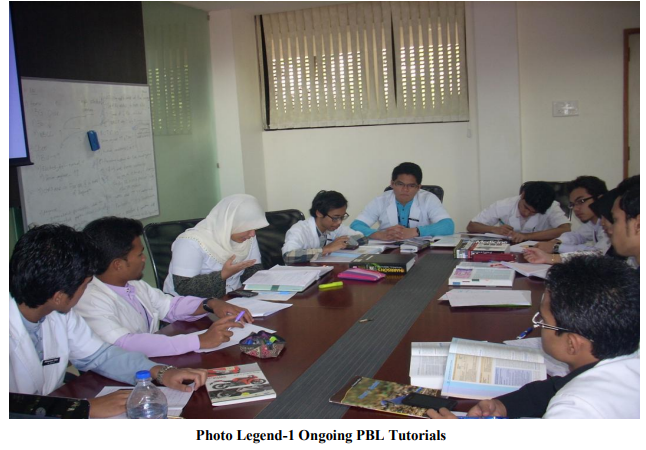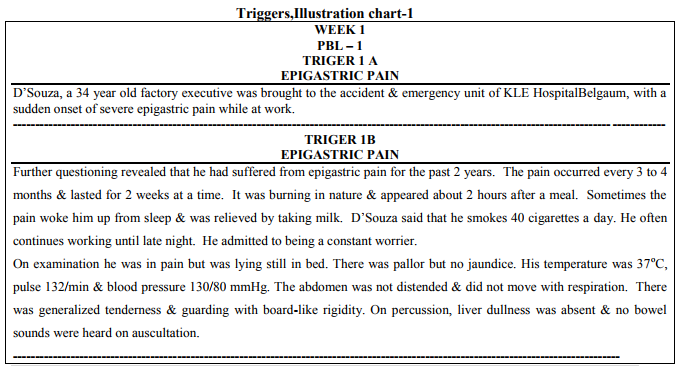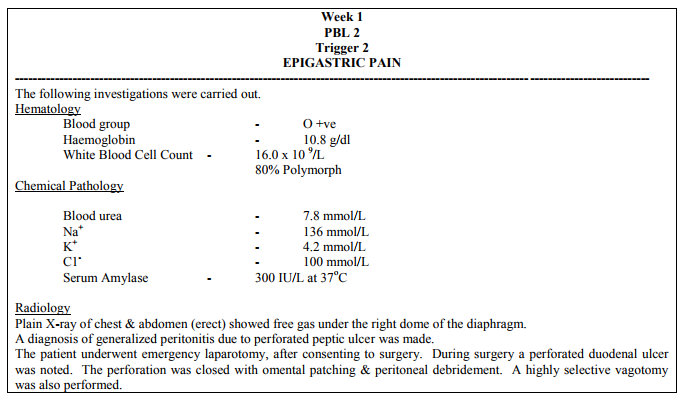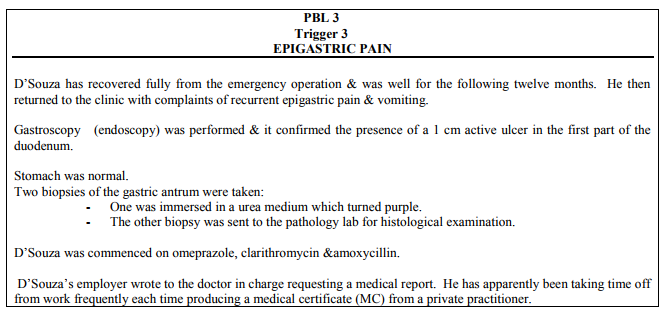IJCRR - 4(15), August, 2012
Pages: 75-81
Date of Publication: 15-Aug-2012
Print Article
Download XML Download PDF
OVERVIEW OF PRACTICE OF PROBLEM BASED LEARNING (PBL)-A REVIEW
Author: Mathada V Ravishankar
Category: Healthcare
Abstract:The clinical decision making is crucial part of medical service were a medical doctor has to deliver his service in an effective manner, understanding the actual problem which is revolving around many close or distally related facts often put medical man under dilemma where timely decision making becomes a great challenge. One can overcome from such circumstances by effective practice of understanding and solving the existing problem which has conceived a new concept of medical learning called Problem Based Learning (PBL) which certainly can boost the confidence of handling any case of simple to complex nature.Here the medical doctor is thoroughly trained to understand his limitationultimately to render a best possible approach towards the problem.Most of the scholars' opinion that education is not just acquiring the knowledge but it is a mere ability to apply the same in practice wherever it is rationally required. PBL is not a just a teaching and learning technique, but it is a strong educational strategy. The present teachers in different fields needs proper updating of their knowledge along with positive attitude of acquiring new skills of teaching, learning and student evaluation to bring out professionally competitive candidates. Based on authors personal experience, for any beginner this article is a lid opener to understand some basic aspects of PBL along with its practice by considering a small illustration.
Keywords: Curriculum, Hypothesis, Paradigm, Trigger.
Full Text:
INTRODUCTION
The problem solving attitude in human has developed since the time of civilization, which is the base for number of invention and discoveries on the earth which not only made life smooth but also sophisticated by influencingthe change in every aspect of life including advanced professional excellence.There are different ways of learning techniques being practiced by an individual, the learning styles differs in different individuals and personalities.In fact physiologically it is a sensory input and motor output which constitutes learning in an individual. Some patterns of learning styles are including Linguistic, Logical, Spatial, Musical, Bodily, interpersonal, intrapersonal2 .The practice of problem based learning was first started in McMaster University in Hamilton during 1969 in Canada1 .Although there are many modes of learning approaches but the ultimate choice is left with the individual3 .The training in specialized medical branch needs an additional stress on the preferred discipline 4 .Learning is a basis for any professionincluding advanced development in wide range of medical specialties5 ,which is not only a crucial part of development of professional attitudes but it is individuals adoption to different circumstances in every aspect to lead a productive and competitive life. The learning theory without its practical application is a worthless effort, in medical curriculumwhich is least effective without the practice of application ofskills. The target of problem based learning is always revolves around some factswhere it needs properunderstanding in a holistic wayto handle the situation efficiently. The PBL is a change from teaching paradigm to learning paradigm; in the medical profession wherethe student hasto learn how to apply their knowledge of theoryin a realistic manner, probably this has conceived the new conceptswhere ?The Problem Based learning? stands as unique.PBL is not restricted to any particular field but it includes Medical/Alternative medicine, Nursing, Physiotherapy, Pharmacy practice, engineeringetc.,whichaims at critical thinking and understanding a problem. The PBL curriculum is practiced since 30 years mostly in western countries,but it is widely accepted around the word by the different disciplines, it is a learner centered approach which aims at selfdirectedlearning (SDL)6 .The PBL learning stands unique against traditional learning where it focus on one way delivery of contents, teaching is subject oriented, teacher alone will be an active participant, and the students are just audience and are passive learners. Students often take home all the information in spite of lack of clarity on the subject in different aspects; this could be due to the inhabitations exhibited by the learners. In contrast to this the PBL is a two way learning, teaching is objective orientated, here the teacher and students both are active participants. The students are having every opportunity to get the clarity on the topic of discussion; they learn the application along with critical thinking. Some new concepts of learning includes horizontal integration, vertical integration and spiral integration where the pre-clinical, Para-clinical and clinical subjects are blended in a typical manner. The new concepts of learning have invariably formulated new methods of student evaluationin medical profession, whichincludes mainly OSPE (Objective Structured Practical Examination), OSCE (Objective Structured Clinical Examination).PBL has spread across the globe its practice especially from recent past 5 years,it is not limited only to medical course but also in different disciplines of education, including technical higher education 7 .It was found that the group of PBL students with different professional course backgrounds were chosen randomlyand they were assessed, it was found that itsoutcomehas profoundinfluence onthe ideas put fourth by the students of different disciplines8 .The PBL not just deals about a difficulty but also on a threat or a challenge, which can be handled through a strong educational strategy which is mainly based on curriculum designing, conduct of PBL Tutorials including other conventional teaching methods and bed side clinical teaching9 . To start with PBL tutorials the student need to have some information about basic medical subjects, usually here it starts from the 2nd year of medical curriculum. The students get the subject related information of any PBL through trigger, it is a lid opener there may be one or more triggers depends on the case or a single trigger may be split into two, generally they are based on the problems which are linked with each other in a rational manner to create a commonly seen clinical scenario during thepractice of medicine.




PBL Tutorials
The ideal PBL tutorials contain 10 numbers of students out of which one student will be selected as scribe who writes on board and often summarizing the information gathered 10(Photo Legend-1). He also can write or insist others to do drawings, schematic diagrams, flow charts, displaying models etc. The PBL learning usually contains three important components which include key words, learning issues and hypothesis, these three factors depends on the contents of the trigger provided, here we have considered some examples of triggers which is more or less tells about the information consideration for our learning. The time duration of each tutorial is 2 hours. The key words are arranged in a regular order to continue the flow of discussion in a sequential pattern. First the key words are written separately in a respective column which drags the initial attention by understanding their meaning, next the learning issues generate the learning information which needs keen attention to carry out the discussions further, the hypothesis is an assumption made on the basis of existing information in the respective trigger, which is based on the learners knowledge on the subject of basic medical science. Generally the trigger one will be given few days in advance so that the students can come with some home work or it can be given on spot by the facilitator/tutor it is often very effective to initiate a good brain storming. This trigger deals with an the initial hint which states about the main complaints, general signs and symptoms, etiology, age, sex, of the patient along with a brief history. Initially the meaning of new terms should be properly understood by referring medical dictionary which is followed by recapitulating and applying all relevant basic information which they have learnt so far related to the trigger one. The trigger two will be provided usually at the end of first day of PBL to motivate further research on the topic. On second day PBL usually start with a briefing about the previous trigger and it will be continued with the discussion of further case events. Usually the trigger II will enhance the case information like alleviating or suppressing factors, correlation of recent/past history, habits, any treatment provided, physical examination followed by out come of lab investigations followed by tentative diagnosis and its management. The trigger three further considers patient for his response followed by the measures taken or further consideration of any advanced investigations needed, which is guiding the students to go towards the discussion of case with other aspects of differential diagnosis including treatment, complications, prognosis, rehabilitation etc. wherever it is applicable, which direct the learning process in a more specific manner. Out of number of hints provided the more relevant one will be co-related with the existing case scenario and a tentative conclusion will be drawn. At the end of completion of discussion all the triggers are properly summarized, stressed and correlated to establish a link with all our points considered for the existing case scenario, to draw tentative hypotheses to go ahead with the consideration of rational medical or surgical treatment. During the course of discussions the triggers opens many questions out of which some may be left unanswered which is leading some confusion which needs proper directions, as the discussion continues the students may gradually disclosing relevant and irrelevant outcomes, out of which the more relevant and applicable one should be chosen and directed into the main stream of discussion by the facilitator. The sufficient time will be provided to go on spot research by using dictionary, text books, notes, atlas or online information etc. For better case understanding we can make use of pictures, photos, X-rays, animations of patient etc. through proper use of internet which makes the case more interesting.
Type of Triggers
The triggers are nothing but information which progressively discloses the events of case scenario (chart 1). The trigger could be in the form of a statement tells about brief information of any illness or it could be a real patient, simulator, photographs, video clipping, x-rays radiographs, MRI or CT scan reports, Lab reports, a family tree showing an inherited disordered or a pedigree charts etc.10 .
Types of Problem
It may be a medical or surgical case of individual, community, family, occupation related,involving cell,system, organs etc1 .The problems may be of realistic or hypothetical nature one which meets the educational objectives 11 .
The role of facilitator
- He should be a medical man who properly trained to conduct PBL Tutorials
- Any medical graduate,but need not to be a specialist in the subject.
- He has to disclose the ground rules and game plan properly12 .
- He should insist for timely use of proper resources to get clarity on the subject.
- He is a silent observer; he is the controller and motivator
- He himself should not try to solve the problem ?
- He has to channelize the discussion in a proper manner by supporting group dynamics
- He needs good preparation and should be aware of learning objectives to be covered
- He should have good body language and he has to prevent the monopoly and dominance by any one student from the group.
- If the student fails to raise the question/learning issues then facilitator has to motivate, often it is done through probing a blank mind.
- In case of the arguments between the students, the facilitator has to generate the learning issues and it should be generalized.
- He should not offer fast food for the students
- Give work to draw, display picture, photo or video clipping and do some action related to the case
- He should be impartial and monitors every student‘s participation to give a correct grading.
Evaluation of Students
The evaluation is based on the performance of students regarding his/her presentation/delivery of content, organization, research/home work, and attempt to establish the problem through the proper linking. Generally the students will be graded from zero to four, depends on the overall involvement of every student, by considering all the sessions of PBL.
Advantages:
1. It facilitates brain storming
2. It is an active and self-directed learning 2. The students comes out of inhibitions
3. Understands way of critical thinking and its application7
4. Learn research through different resources
5. makes more competitive 6. Motivates advanced thinking
7. Understanding the problem through holistic approach
8. Learn team work and sharing the information.
9. It creates rappo between teacher and students
10 Boost the self confidence
Disadvantages:
1. It needs more man power
2. Its needs more space and material
3. Opens many unanswered questions
4. Students tend to ignore the basic subject informations
5. Time constrains to complete the objective
6. Often detailed history remains as a mystery and available information in the trigger is limited.
7. The respective block system will guide the possible case scenario and make them more prejudiced about the case
8. Extensive triggers and multiple objectives
9. Students are having limited knowledge
10. Often lead to confusion among students and tutor feels uncertain about on going discussions10 .
ACKNOWLEDGEMENT
The author would like to sincerely acknowledge the guidelines from his teacher Dr Nor Haiyati, University Sains Malaysia (USM) Malaysia, who has conducted the PBL workshops.
CONCLUSION
The practice of PBL may differ in many ways but it supports the strong establishment of connection between methodology of teaching and the complexity of learning in students in analytical manner. The quality of outcome of PBL Learning is solely depends on the quality of trigger which is built with relevant case scenario under the guidelines of expertise so that it can facilitate the student to act independently to construct an algorithm from clinical decision making to practical problem solving. The PBL learning is further continued with advanced practical/clinical case studies of more or less a similar case scenario with the bed side case discussion. The teachers who are following the medical curriculum which is including the traditional method of teaching and learning are often difficult to convince to practice PBL; many times they are reluctant to adopt a new concept of delivery of content unlike conventional teaching. Their strong mind set up and their long professional experience may impend towards new concept of learning, in fact when we compare the outcome between the students who have undergone PBL learning and conventional method of learning both were found with equally competitive attitude towards understanding a problem. In spite of endless arguments regarding the superiority and acceptance of any type of teaching practices one has to abide there mind set up to a small change to bring an effective out come in the field of medical education
References:
1. Mantle S. The seven learning styles. www.authorsden.com.education/ training articles. Date of access 4-6-2012.
2. KarimiR.Interface between problem based learning and learner-centered paradigm. Advances in medical education and practice.2011:2:117-125.
3. Lujan H LandDiCarlo S E. First-year medical students prefer multiple learning styles, Advanced Physiological Education. 30:13-16 2006.
4. Engels P T and Gara C D. Learning styles of medical students, general surgery residents, and general surgeons: Implications for surgical education.BMC medical education.2010:10:51.http://www.biomedcentr al.com/1472-6920/10/51.Date of access 4-6- 2012.
5. FreyerA.Comparison of preferred learning methods between medical students and postgraduatemedicalstaffwww.nottingham.ac. uk/pesl/resources/styles/comparis708/cached. Date of access 4-6-2012.
6. Savery J R. "Overview of Problem-based Learning: Definitions and Distinctions". Inter disciplinary journal of problem based learning. 2006:1(3). Available at:http:/docs.lib.purdue.edu/ijpbl/vil1/iss1/3.D ate of access 4-6-2012
7. DouvlouD.Effective teaching and learning: Integrating problem based learning in the teaching of sustainable design, CEBE Transactions.2006:3(2)23-37.
8. Nango E andTanakY.Problem based learning in a multidisciplinary group enhances a clinical dicision making by medical students: A randomized controlled trial.Journal ofMedical Dental Science. 2010 57:109-118.
9. Terry Barrett. Understanding problem – based learning. www.aishe.org/reading/2005- 2/chapter2.pdf. Date of access 17-6-2012.
10. Wood D F.ABC of learning and teaching in medicine.Problem based learning.British medical journal.2003:326,328-330.
11. Erik D G, Kolmos A. Characteristics of Problem based learning. International Journal of Engineering Education. 2003:19(5)657-662.
12. Azer S A. Challenges facing PBL tutors: 12 tips for successful group facilitation. Medical Teacher. 2005:27(8) 676-681.
|






 This work is licensed under a Creative Commons Attribution-NonCommercial 4.0 International License
This work is licensed under a Creative Commons Attribution-NonCommercial 4.0 International License